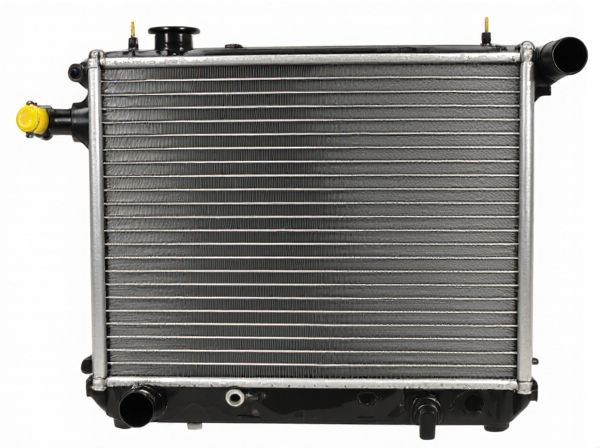
Photo illustration: Soldered Joint vs Brazed Joint Radiator
Soldered joints in radiators provide a strong, leak-resistant bond by melting a filler metal at relatively low temperatures, ideal for delicate or thin materials. Brazed joints use higher temperatures to create a more robust and heat-resistant connection, making them suitable for heavy-duty radiator applications. Your choice depends on the radiator's operating conditions and required durability.
Table of Comparison
| Feature | Soldered Joint Radiator | Brazed Joint Radiator |
|---|---|---|
| Joint Method | Soft solder alloy (e.g., tin-lead) | High-temperature filler metal (e.g., silver-based) |
| Operating Temperature | Up to 200degC | Up to 450degC |
| Mechanical Strength | Moderate strength suitable for standard cars | High strength for heavy-duty applications |
| Corrosion Resistance | Good resistance with proper flux | Superior corrosion resistance |
| Leak Resistance | Prone to leaks if not done carefully | More leak-proof due to stronger bonding |
| Cost | Lower production cost | Higher production cost |
| Repairability | Easier to repair and re-solder | Harder to repair, often requires full replacement |
| Application | Standard passenger cars | Performance vehicles, heavy trucks, industrial use |
Introduction to Radiator Joints
Radiator joints, essential for ensuring efficient heat exchange and fluid containment, are commonly classified as soldered or brazed based on their joining techniques. Soldered joints utilize lower melting point alloys like tin-lead, creating a strong yet flexible bond ideal for delicate radiator tubes. Brazed joints employ higher temperature filler metals such as silver or copper alloys, resulting in a robust, corrosion-resistant connection suitable for high-performance radiator applications.
What Is a Soldered Joint?
A soldered joint in radiators involves joining metal parts using a filler metal with a melting point below 450degC, creating a strong, corrosion-resistant bond without melting the base metals. This technique is ideal for delicate radiator components, ensuring minimal thermal stress and maintaining structural integrity. Compared to brazed joints, soldered joints provide superior flexibility but may have lower mechanical strength and temperature resistance.
What Is a Brazed Joint?
A brazed joint in radiators involves joining metal parts by melting a filler metal with a melting point above 450degC, which flows into the joint by capillary action without melting the base metals. This process creates a strong, leak-proof bond ideal for high-pressure and temperature applications in automotive and industrial radiators. Compared to soldered joints, brazed joints provide superior mechanical strength and corrosion resistance, making them suitable for demanding thermal management systems.
Key Differences Between Soldered and Brazed Joints
Soldered joints in radiators typically use a lower melting point alloy, resulting in less thermal stress and easier repair but generally lower mechanical strength compared to brazed joints. Brazed joints employ higher melting point filler metals, offering superior strength, enhanced corrosion resistance, and better performance at elevated temperatures. The choice between soldered and brazed joints impacts radiator durability, leak resistance, and suitability for high-pressure applications.
Strength and Durability Comparison
Soldered joint radiators offer moderate strength suitable for lower pressure heating systems, while brazed joint radiators provide superior strength and durability capable of withstanding higher temperatures and pressures due to the higher melting point of brazing alloys. Brazed joints create a metallurgical bond that enhances resistance to mechanical stress and thermal expansion, resulting in longer service life compared to soldered joints, which rely on softer fillers prone to fatigue and leakage. The choice between soldered and brazed joints directly impacts the radiator's performance in demanding industrial applications requiring enhanced reliability and longevity.
Temperature Resistance: Soldering vs Brazing
Brazed joints in radiators exhibit superior temperature resistance compared to soldered joints, with brazing capable of withstanding temperatures up to 900degF (482degC) or higher due to the use of filler metals with higher melting points. Soldered joints typically endure temperatures only up to 400degF (204degC), making them less suitable for high-heat applications. This temperature resilience makes brazed joints preferable for radiators operating under high thermal stress and demanding environments.
Cost and Manufacturing Considerations
Soldered joint radiators typically incur lower manufacturing costs due to simpler processes and the use of less expensive filler metals like tin-lead or tin-silver alloys. Brazed joint radiators, involving higher-temperature brazing with copper or silver-based fillers, demand more precise control and energy input, increasing production expenses but offering superior mechanical strength and thermal conductivity. Cost considerations weigh heavily on volume production, where soldered joints favor affordability, while brazed joints justify their expense in high-performance applications requiring enhanced durability.
Common Applications: When to Use Each Method
Soldered joint radiators are commonly used in household heating systems and small-scale HVAC applications due to their ease of assembly and suitability for copper and brass components operating at lower temperatures. Brazed joint radiators are preferred in industrial and automotive cooling systems where higher temperature resistance, mechanical strength, and durability under pressure are critical. Selecting soldering is ideal for maintenance and repair of existing copper piping, while brazing is the method of choice for new installations requiring robust joints capable of withstanding harsh environments.
Longevity and Maintenance Issues
Soldered joint radiators typically offer excellent thermal conductivity but are more prone to joint failure over time due to lower melting points and susceptibility to corrosion, impacting longevity and increasing maintenance needs. Brazed joint radiators provide superior strength and durability by utilizing higher melting point filler metals, resulting in longer lifespan and reduced risk of leaks or joint degradation. Maintenance issues in brazed joints are generally less frequent, as the robust bond withstands thermal cycling and mechanical stress better than soldered connections.
Choosing the Right Joint for Your Radiator
Selecting the right joint for your radiator involves understanding the differences between soldered and brazed joints. Soldered joints use a lower melting point alloy, making them ideal for delicate radiator components and applications requiring precision without overheating. Brazed joints provide stronger, more durable connections capable of withstanding higher temperatures and pressures, making them suitable for heavy-duty radiators in industrial or high-performance environments.
 caratoz.com
caratoz.com